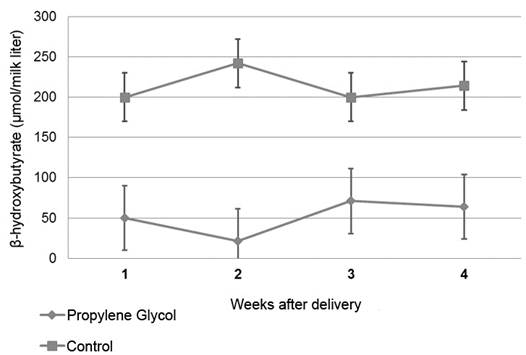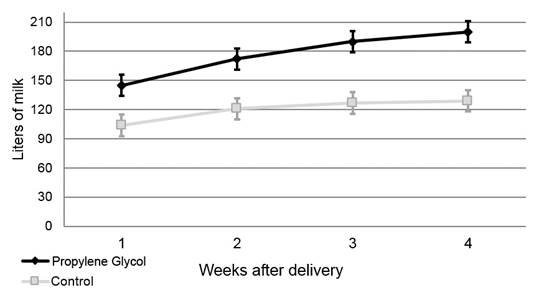INTRODUCTION
The success of the productive cycle of a dairy cow depends to a large extent on the peripartum period (Grummer, 1995). The period of transition also called by some peripartum persons, revolves around birth and has been defined in various ways, but in general it is considered as the period that goes from three weeks before to three weeks after birth (Drakley, 1999). In the dairy cow, the transition period associated with birth is the most important because of all the implications it has on the presentation of various metabolic, productive and reproductive dysfunctions (Dick et al., 1995, Butler, 2003).
At the beginning of lactation, there is an accelerated increase in nutritional requirements (Butler, et al., 2006), causing a negative energy balance, which can last for several weeks. The negative energy balance (BEN) is universal in dairy cows during the first weeks of lactation, and most of them do not develop diseases (Cardoso, 2008). In addition, it is relevant to indicate that the BEN can be started before delivery; Grummer, (1995) reported that during the last weeks of pregnancy there is a decrease in dry matter consumption promoting the negative energy balance.
Jorritsma et al., (2003) observed that the negative energy balance is caused by an inadequate hepatic biosynthesis of glucose, as confirmed by Wieghart et al., (1986) by indicating that the hepatic glucose production is directly proportional to the biosynthesized propionic acid in the rumen. The use of propylene glycol (PG), which acts as a precursor of glucose in the liver, could provide energy and help reduce the negative energy balance (Dann et al., 1999).
The objective of the study was to determine the effects of PG delivered orally during peripartum on changes in body condition, milk production, milk concentrations of β-hydroxybutyrate, prevalence of subclinical ketosis and open days in dairy cows in the tropic of Veracruz.
MATERIAL AND METHODS
The present study was conducted in the livestock production unit, located in Tihuatlan municipality, Veracruz, Mexico. It has an average annual temperature of 22 °C and an average annual rainfall of 1,076 mm.
The cows were managed in an intensive rotation system of 23 hectares and 53 divisions of Brizanta grass (Brachiaria brizantha) and Estrella de África grass (Cynodon plectostachyus); they were also provided with Taiwan chopped grass (Pennisetum purpureum schum), orange peel silage, mineral salts and fresh water at free access.
Multiparous cows (n=36) were used, which were incorporated into the milking herd 3 weeks before the approximate delivery date. At that time they were administered ivermectin (IVOMEC® 1%, Boehringer Ingelheim, Mexico), subcutaneously (0.2 mg/kg), intramuscularly Vitamin E (60 mg), Selenium (600 mg), (MU-SE®, MSD Health Animal, Mexico) and Vitamin ADE (A, 250,000 IU; D3, 375,000 IU and E1 alpha-69 tocopherol acetate, 250 mg), (Vigantol® ADE, Bayer, Mexico) and received daily 2 kg of balanced feed at 18% crude protein. They were divided into two groups randomly selected, the first group received 250 ml of propylene glycol (PG) (n=18) orally once a day, and the second group (control group) were given 250 ml of clean water and by the same way (n=18). This procedure was continued until the third week after delivery.
The cows were milked mechanically in a stationary type milking system, also known as cubicle stabling. Milking was done twice a day (5:30 am and 2:30 pm). Upon entering the milking crate, the cows were trapped in the head. In front of the trap the cows had a trough that allowed them to feed during milking. All cows during milking were provided with an 18% raw protein supplement at a rate of 1 kg per 3 liters of milk produced. The milk was weighed daily using milk weighers integrated into the milk line (Waikato®).
Three weeks before delivery and until the fourth postpartum week the body condition of the cows was recorded weekly, based on the scale of 1- 5,1 being very thin and 5 obese (Ferguson et al., 1994).
From each cow in the milking line, a milk sample was obtained every 7 days during the 4 weeks after delivery. These samples were quantified the BHBA concentration to determine the degree of subclinical ketosis; the cut-off point for subclinical ketosis was ≥200 μmol/l. Strips of keto-Test® (Elanco) were used to determine these concentrations. When the milk sample was obtained, the keto-Test® strip was immersed and remained at least 3 seconds, the excess was removed and removed; subsequently it was measured with the table to see the degree of subclinical ketosis.
The statistical analysis was performed using the STATISTICA 7 software with the ANOVA, and Chi-square models. The dependent variables were: milk production (liters), degree of subclinical ketosis, number of animals per group that presented subclinical ketosis and open days. The dependent variable was the treatment and time (week).
RESULTS
A treatment effect (P ≤ 0.05) on body condition was found. The cows treated with PG maintained a better body condition at postpartum fourth week (3.21 ± 0.18), compared with the control cows (2.7 ± 0.18). In general, the group under treatment presented a better body condition (3.4 ± 0.035) compared to the control group (3.10 ± 0.034). Likewise, the group with PG had lower (P ≤ 0.05) concentration of β-hydroxybutyrate in milk (51.6 ± 41.0 μmol/l) during the fourth weeks after delivery, compared with the control group (214.5 ± 41.6 μmol/l, see Figure 1).

Figure 1 Concentrations of β-hydroxybutyrate in milk of cows affected by treatment and week (P≤0.05) after delivery.
Cows in the group treated with PG had concentrations of β-hydroxybutyrate in milk lower than 200 μmol/liter, resulting in a prevalence of subclinical ketosis of 0%; however, in the control group 64% of the samples showed concentrations of β-hydroxybutyrate in milk equal to or greater than 200 μmol/liter, considering subclinical ketosis. Additionally, the group with PG showed a greater increase in milk production (P˂ 0.05), during the first 4 weeks after delivery (see Figure 2) and produced more milk per lactation (3,120.0 ± 197.4 liters) than the control group (2,186.8 ± 197.4 liters). The cows in the PG group had a daily average of 10.22 ± 0.64 liters adjusted to a lactation of 305 days, compared with the cows of the control group that had a daily average of 7.2 ± 0.64 liters. Finally, the treatment did not affect the number of days open (P=0.10), since the group with PG had a number of open days similar to the control group (163.0±10.5 vs. 160.3±12.2).
DISCUSSION
The results of the study indicate that cows treated daily with 250 ml of PG starting 3 weeks before the expected date of delivery until 3 weeks after delivery, had a better body condition. These results are confirmed by Laranja et al., (2004) who reported that cows treated with PG had 0.3 more body condition score than control cows. It has been shown that the use of PG drastically reduces the mobilization of body fat in cows in the first weeks postpartum (Nielsen and Ingvartsen, 2004) and this can contribute to reduced cows losing body condition, which could be an advantage.
Treatment with PG was very effective in reducing the concentrations of β-hydroxybutyrate in milk and the prevalence of subclinical ketosis. The effect of the use of PG in reducing the concentrations of β-hydroxybutyrate in plasma and milk have been previously reported (Formigoni et al., 1996). PG is rapidly absorbed in the rumen and small intestine and increases glucose levels in blood within minutes, reducing fat mobilization and negative energy balance, resulting in lower concentrations of β-hydroxybutyrate and consequently low prevalence of subclinical ketosis (Miyoshi et al., 2000).
Cows in the PG group had higher milk production during the first 4 weeks after calving and higher milk production per lactation; this is in sync with a report from Texas A & M University that was conducted with 110 multiparous cows and 58 primiparous cows, where an increase in milk production was demonstrated. In addition, there is a publication of a meta-analysis that included 13 scientific publications and about two thousand cows, where the conclusion was that PG treatment increased milk production 2.1 kg per day (mentioned in: Nielsen and Ingvartsen, 1996). Although there are reports indicating that there is no benefit of treatment with PG in milk production (Laranja et al., 2004). Perhaps the difference between some studies may be due to the dose, duration and frequency of PG administration.
There were no differences in the number of open days between cows treated with PG and cows in the control group. Similar results were published by Laranja et al., (2004). This may be due to the fact that the energy contribution of the PG was only given until week 3 after delivery and the peak production occurs several weeks later, so the effect of the PG is not so prolonged. More research is recommended during these stages of breastfeeding and its reproductive effects.
CONCLUSION
The daily intake of 250 ml of propylene glycol continuously starting 3 weeks before delivery until 3 weeks after delivery, improved different parameters in dairy cows of the tropic Veracruz. The propylene glycol intake helped the cows maintain a better body condition, increased milk production by lactation and decreased the concentrations of β-hydroxybutyrate in milk and prevalence of subclinical ketosis; however, the treatment had no benefit in the number of open days.











 texto em
texto em 




